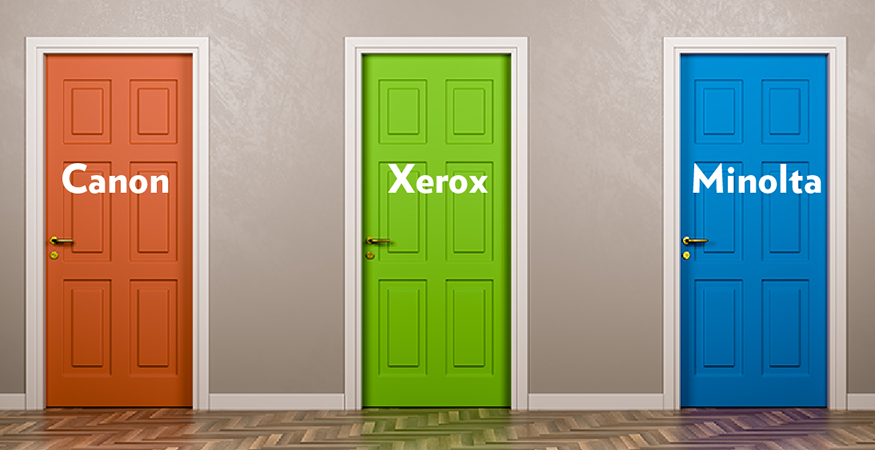When you’re choosing a printer, copier or multifunction device for your company, it’s important to consider more than just technical specifications. You are starting a long-term relationship with your vendor, and you need to know the technology will be supported and continue to evolve.
Unfortunately, when it comes to major print manufacturers, not all makers are equal. Canon, Konica Minolta and Xerox are among the oldest and most venerable printer vendors, but these companies are all on different trajectories.
Here’s what you need to know when choosing among these three printer, copier and multifunction device makers.
PICKING A PRINTER PARTNER
Most office printers, copiers and multifunction devices have an expected lifespan of five to seven years, although many will be in service for a decade or more. Choosing the right manufacturer is as important as the price and output capabilities.
Xerox produced the first modern, commercial printer in 1973 and its name was once synonymous with copying. However, the company hasn’t even announced a new office printing device since June of 2019. According to industry analysts, “their reseller community is beyond frustrated for reasons ranging from support issues to lack of product.”
In fact, since 2019, Xerox reported in annual statements that total revenue was down over $2 billion, and sales of commercial grade equipment fell 27.8% while office copier sales are down 30.8%. This is a huge and precipitous fall for the once-innovative company.
When it comes to Xerox machines, parts are often hard to come by, are more expensive and the number of technicians available to service them is shrinking. Xerox has laid off almost 25% of its workforce since 2018, and many of their experienced technicians have been hired by other manufacturers and service providers.
Much like Xerox, Konica Minolta copier models use proprietary parts that are difficult to source or replace. For example, Konica uses special parts called imaging units. Each device uses multiple imaging units, and each one costs about $500 to replace. The company also experienced a catastrophic fire in its toner plant in 2021, resulting in supply disruptions and delays. According to interviews with executives, the company is still working to recover and rebuild its supply chain.
How Canon is better than Xerox and Konica Minolta
While Xerox and Konica Minolta have experienced contraction and supply issues in recent years, Canon has managed to continue innovating. Canon's largest division in terms of revenue is its multifunction copier division and this technology has long been the focus of the company’s R&D budget, which was 2.6 billion in 2021.
Canon has earned the EPA’s ENERGY STAR Partner of the Year – Sustained Excellence Award and the A3 Line of the Year Award from Keypoint Intelligence. Canon service is provided through an Authorized Dealer Network (which includes GFC) and has not experienced significant layoffs in recent years.
As you can see, companies like Konica Minolta, Xerox and Canon all have very different product offerings, service capabilities and technology. To ensure you are getting an apples-to-apples comparison you can also research and compare the different copier models you are receiving quotes for by using a service like Buyer’s Lab Inc. BLI is a third-party research company that tests and compiles results for the various printer models and brands. They even offer a unique comparison tool that allows you to see specifications of different models side-by-side.
If you are currently researching copiers but don’t have access to Buyer’s Lab, contact the Gordon Flesch Company. As mentioned, we represent Canon, Ricoh and Lexmark so we can provide the optimal mix of hardware and software solutions no matter what your business requirements may be. Contact us today.










